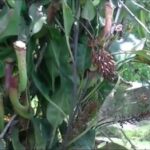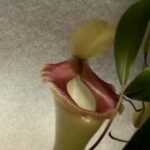As an Amazon Associate, this site earns commissions from qualifying purchases. For more details, click here.
Nepenthes x ventrata is the product of n. ventricosa and n. alata. It is known for having sizeable red-green pitchers and being highly adaptable to different environments. Read on to find out how to best take care of nepenthes x ventrata – or just n. ventrata – in your home and what mistakes to steer clear from.
Nepenthes x ventrata grows in indirect light indoors or partial to full sun outdoors. Use sphagnum moss, perlite and sand for the soil and keep it moist. This plant does not have a dormancy period and thrives in mild temperature with high humidity.
Nepenthes x Ventrata Care Sheet
| Soil | Peat moss and perlite, keep soil moist |
| Water | Distilled, spring, purified |
| Light | 6-8 hours partial to full light, grows in artificial lights |
| Food | Small insects, freeze dried mealworms, fish food |
| Temperature | 65-80 F (18.3 to 26.6 C) |
| Humidity | 70% |
| Dormancy | No |
| Propagation | Cuttings |
Soil
Nepenthes x ventrata prefers live sphagnum moss. Standard nepenthes potting soil or Rio Hamza Trading Sphagnum Moss may be used as well. The plant responds well to a mixture consisting of 3:1 sphagnum moss and perlite. If perlite is not available, charcoal, pumice or orchid bark may be used.
Some prefer peat moss to sphagnum for nepenthes, but for n. ventrata LFS seems to work better. Equal parts perlite and sphagnum moss is ideal in many cases.
The simplest approach for beginners is to buy n. ventrata potted or with premixed soil. This saves you the trouble of preparing potting media and can focus on setting up its environment. You can always try new soil media when you propagate.
Some nepenthes potting mixes have additional ingredients such as silica sand, orchid bark or bits of lava rock. You can add these if you are going to prepare a custom potting mix.
Do not use nutrient rich soil or fertilizer because it can kill the plant. Keep the soil airy and moist without being too damp. If the soil starts breaking down, repot your nepenthes. Do not wait for root rot or bacteria to infect your plant before doing this.
Pot Container
Nepenthes x ventrata are usually sold in a 4 inch pot, while larger variants come in a 6 inch hanging container. Large containers are available for bigger plants so it will not be an issue.
Since the pot is sold with the plant you do not have to worry about the size or material. If you need to repot or grow a new plant through propagation, just order another container.
Containers come in two basic types, pot and hanging. Which you choose depends on how you want to display your nepenthes. Either way you have to water the plant properly and provide sunlight for it to grow.
Nepenthes are usually repotted each spring. You may repot every two years if the plant is healthy but it is a good idea to do it each spring to give the plant a fresh start.
Water
Water from the top until the soil is moist. In mild weather you can water 2-3 times a week. Do it more often during summer to prevent the plant from drying out.
However you must be careful not to overwater. There are many reasons why pitcher plants turn black and overwatering is one of them. Moist soil is necessary but do not drench the plant.
You may use the tray method if the climate is really hot and dry. This is also an easy way to increase humidity to stimulate growth. But you should limit the volume of water to prevent root rot.
Set the pot in a tray and pour 0.5 to an inch of water. The water makes it way into the roots through the pot hole, moistening the soil. Use spring, distilled, spring or purified water.
Add water to the tray as it empties. You should only increase the level if the leaves are drying out. You should also partially cover the plant to reduce light exposure.
Light
Nepenthes x ventrata can grow indoors or outdoors. You can set the plant on a south facing window or leave it outdoors partially shaded. Artificial plant lights are also effective.
Indoor lighting. Place your n. x ventrata on a sunny window. The window should face south if you are in the northern hemisphere. If you are in the southern hemisphere, the window should be oriented north.
This setup is a good example of bright, indirect light. The window prevents direct light from hitting the plant, but enough reaches it to provide energy. You can even use this with the tray method, with the water complementing the light.
Grow lights may also be used, and one we like is the Durolux HD T5 because it is efficient and simulates the sun to keep your nepenthes healthy in winter. These pitcher plants do not require dormancy and need the same amount of light all year.
Outdoors. Position the pot or hanging basket so that it is partially shaded. Do not completely cover the plant, just enough so it is not directly under the sun.
Too much sun and not enough water is bad for nepenthes. It can lead to empty pitchers, dry leaves and eventually the plant will die. If the leaves are dry and there is no liquid in the pitcher, the plant is suffering from too much heat.
Temperature
Keep nepenthes x ventrata in temperature between 65-80 F (18.3 to 26.6 C). Do not allow the temperature to drop below 50 F (10 C). While 80 F is the ideal maximum, n. ventrata can handle up to 90 F or higher if there is enough humidity.
Just like n. ampullaria, nepenthes ventrata is forgiving when it comes to temperature. While 65-80 F is optimal the plant will survive in less than perfect conditions. As long as the temperature is above 50 F and lower than 95 F your nepenthes ventrata will live.
Of course you want the plant to do more than just live, you want it to flourish. If the temperature is too hot, increase the humidity to help the plant. If it is too cold outdoors, bring the plant indoors to a warmer location. So even if temperature is not ideal there are ways you can adjust it.
Humidity
Nepenthes x ventrata prefers high humidity around 70% or more. Do not let humidity drop below 50% as this could cause serious damage.
If the humidity is too low, nepenthes will only produce a small number of pitchers. This also limits the amount of liquids the plant can create for each trap. There are ways to increase humidity if necessary.
First you can use a fogger or humidifier. Either one should be enough to boost humidity. Another option is the tray method. As discussed earlier this can be used during dry, low humid conditions.
It is easier to control humidity indoors so keep that in mind when growing n. x ventrata. But if the weather is mild in your area, the humidity might be high enough.
Nutrition and Feeding
To feed nepenthes x ventrata, drop a few bits of food – dried worms or fish pellets for example – in its pitcher. You can do the same with live or dead bugs.
Nepenthes x ventrata feeds on yellow jackets, wasps and other large insects. Its pitchers are able to trap quite a number of bugs especially if they are small.
Outdoor nepenthes catch their own prey. You only have to feed nepenthes x ventrata if it is indoors and unable to lure prey. Fortunately you do not have to hunt for insects to feed it. Freeze dried worms or fish beta pellets will be enough.
Dormancy
Nepenthes x ventrata does not require dormancy. The plant should not be exposed to freezing temperature during winter. You should only keep this plant outdoors during fine weather. If you live in a warm, tropical climate you can grow nepenthes outdoors the whole year.
Grow your nepenthes indoors if your region has freezing winters. Use a humidifier, heat source and artificial lights to keep the plant in a suitable environment. Water the plant as you normally would.
Some species experience slow growth during winter but that is normal. When winter ends, you can repot or propagate the plant as you wish.

My fascination with carnivorous plants began many, many years ago with Venus Fly Traps. Now I am more than happy to impart what I know with other enthusiasts and those who are curious about meat eating plants.



